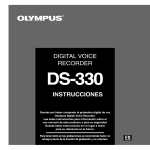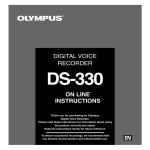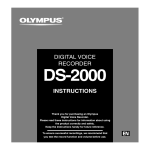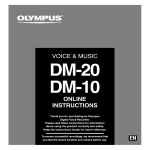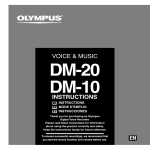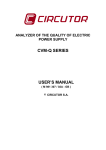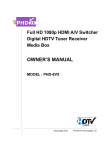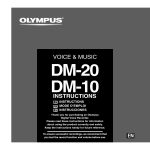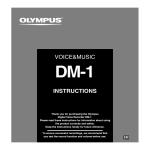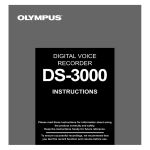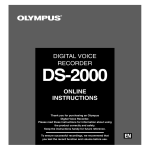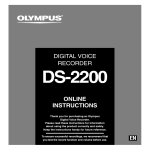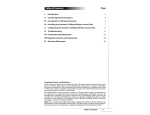Download Olympus DS-660 Handheld Digital Voice Recorder
Transcript
DIGITAL VOICE
RECORDER
DS-660
INSTRUCTIONS
Thank you for purchasing an Olympus
Digital Voice Recorder.
Please read these instructions for information
about using the product correctly and safely.
Keep the instructions handy for future reference.
To ensure successful recordings, we recommend that
you test the record function and volume before use.
EN
1
Safe and Proper Usage
Before using your new recorder, read this
manual carefully to ensure that you know
how to operate it safely and correctly.
Keep this manual in an easily accessible
location for future reference.
• The warning symbols indicate important
safety related information. To protect yourself
and others from personal injury or damage
to property, it is essential that you always
read the warnings and information provided.
Using the Online Manual
When you install the DSS Player Pro on your
PC from the CD-ROM, you can use an online
expanded version of this instruction manual,
allowing you to learn more about the digital
voice recorder.
If the DSS Player is installed, click the [Start]
button, select [All Programs], then [ OLYMPUS
DSS Player Pro], then click [DS-660
Instructions]. You can read more about the items
listed below.
Continuous Playback (ALL PLAY) .............. 22
LCD Contrast Adjustment (CONTRAST) ...... 32
Backlight (BACKLIGHT) ............................33
Moving Files Across Folders ...................... 38
System Sounds (BEEP) ............................. 40
Uninstalling Software ................................. 49
Upload Voice Files to the Recorder ............ 60
Direct Recording on PC and Editing on PC ... 62
Changing User ID (Author ID) .................... 65
Changing a Folder Name ........................... 66
Editing File Comments ............................... 66
Editing a Template .....................................67
2
Using Voice Recognition Software (optional) ... 68
USB Microphone/
USB Speaker (USB AUDIO) ................ 72
Send Voice Files with E-mail ...................... 74
How to Install and Activate Mail Function ... 75
General Precautions
● Do not leave the recorder in hot, humid
locations such as inside a closed
automobile under direct sunlight or on
the beach in the summer.
● Do not store the recorder in places
exposed to excessive moisture or dust.
● Do not use organic solvents such as
alcohol and lacquer thinner to clean the
unit.
● Do not place the recorder on top of or
near electric appliances such as TVs or
refrigerators.
● Avoid recording or playing back near
cellular phones or other wireless equipment,
as they may cause interference and noise.
If you experience noise, move to another
place, or move the recorder further away
from such equipment.
● Avoid sand or dirt. These can cause
irreparable damage.
● Avoid strong vibrations or shocks.
● Do not disassemble, repair or modify
the unit yourself.
● Do not operate the unit while operating
a vehicle (such as a bicycle, motorcycle,
or go-cart).
● Keep the unit out of the reach of
children.
<Warning regarding data loss>
Recorded content in memory may be
destroyed or erased by operating mistakes,
unit malfunction, or during repair work.
It is recommended to back up and save
important content to other media such as
a computer hard disk.
Batteries
Warning
• Batteries should never be exposed to
flame, heated, short-circuited or
disassembled.
• Do not attempt to recharge alkaline,
lithium or any other non-rechargeable
batteries.
• Never use any battery with a torn or
cracked outer cover.
• Keep batteries out of the reach of
children.
• If you notice anything unusual when
using this product such as abnormal
noise, heat, smoke, or a burning odor:
1 remove the batteries immediately while
being careful not to burn yourself, and;
2 call your dealer or local Olympus
representative for service.
AC Adapter
Warning
• Do not attempt to disassemble, repair or
modify the AC adapter in any way.
• Keep foreign objects including water,
metal, or flammable substances from
getting inside the product.
• Do not moisten the AC adapter or touch
it with a wet hand.
• Do not use the AC adapter in the vicinity
of flammable gas (including gasoline,
benzine and lacquer thinner).
In case
• ... the internal parts of the AC adapter
are exposed because it has been
dropped or otherwise damaged:
• ... the AC adapter is dropped in water, or
if water, metal flammable substances or
other foreign objects get inside it:
• ... you notice anything unusual when
using the AC adapter such as abnormal
noise, heat, smoke, or a burning odor:
1 do not touch any of the exposed parts;
2 immediately disconnect the power
supply plug from the power outlet, and;
3 call your dealer or local Olympus
representative for servicing. Continued
use of the AC adapter under these
circumstances could result in electric
shock, fire or injury.
3
Main Features
● The recorder stores highly compressed
DSS format voice messages in 32 MB
integrated flash memory.
● The recorder supports two recording
modes, SP (Standard Playback) mode or
LP (Long Playback) mode (☞ P.18).
• Continuous recording time is approximately 5 hours
and 10 minutes in SP mode and approximately 11
hours in LP mode.*1
● The five folders can hold 199 files each,
for the maximum of 995 recordings (☞
P.12).
● You may assign your own names to folders
(☞ P.31).
● Recorded files may be moved from one
folder to another.
● Has a built-in Variable Control Voice
Actuator (VCVA) function (☞ P.16).
● You can insert or delete index marks (☞
P.28).
● You can input file comments.
● The recorder has Fast Playback and Slow
Playback functions to control playback
speed (☞ P.21).
● If you connect the recorder to a computer,
you can use it as a USB microphone or
USB speaker. *2
● The large LCD screen with backlight can
be easily read even in the dark.
● The recorder has a Noise Cancel Function
(☞ P.26).
4
● Comes with DSS Player software (☞ P.38).
● A USB connected Cradle for data download
from the recorder to the PC (☞ P.44).
*1: Available recording time for one continuous file.
Available recording time may be shorter if many short
recordings are made. (The displayed available recording
time and recorded time are approximate indications.)
*2: Do not use with Windows 98 as computer operation may
become unstable.
..........................................................................
IBM and PC/AT are the trademarks or registered
trademarks of International Business Machines
Corporation.
Microsoft and Windows are registered trademarks
of Microsoft Corporation.
Apple, Macintosh, iMac, Mac, and PowerMac are
trademarks or registered trademarks of Apple
Computer, Inc.
Intel and Pentium are registered trademarks of Intel
Corporation.
Adobe and Acrobat Reader are registered
trademarks of Adobe Systems Incorporated.
CORTOLOGIC is a registered trademark of
Cortologic AG.
Other product and brand names mentioned herein
may be the trademarks or registered trademarks of
their respective owners.
Table of Contents
Getting Started
Identification of Parts ................................. 6
Inserting Batteries ...................................... 8
Using the AC Adapter ................................ 9
Hold ........................................................... 9
Setting Time/Date (TIME&DATE) ............. 10
Basic operations
Recording ................................................ 12
Using the Variable Control
Voice Actuator (VCVA) ...................... 16
Recording Modes (REC MODE) .............. 18
Microphone Sensitivity ............................. 19
Playing .................................................... 20
Erasing .................................................... 22
Noise Cancel Function ............................. 26
Other functions
Locking Files (LOCK) ...............................
Index Marks .............................................
Alarm Playback Function (ALARM) ..........
Assigning Folder Names (FolderName) ...
Assigning File Comments (COMMENT) ..
27
28
29
31
34
LCD Display Information .......................... 35
Formatting the Recorder (FORMAT) ........ 36
Menu List ................................................. 37
38
40
43
44
46
Window Names ....................................... 48
Download Voice Files from the Recorder .... 49
Play a Voice File ...................................... 51
Alarm Message List ................................. 52
Troubleshooting ....................................... 53
Accessories (optional) ............................. 54
Specifications .......................................... 55
Technical Assistance And Support ........... 55
Managing Files on Your PC
Using DSS Player Software .....................
Installing Software ...................................
Using Online Help ....................................
Connecting to Your PC ............................
Running DSS Player ................................
Other Information
5
Identification of Parts
1 2 3
Identification of Parts
4
-
&
)
5
$
6
7
8
9
#
0
^
%
(
=
q
*
e
!
r
@
6
1
2
3
4
5
6
7
8
9
0
!
@
#
$
Built-in microphone
Record/Play indicator lamp
Microphone jack
VOLUME control
NEW button
REC (Record) /SET button
INDEX button
REW (Rewind) /– button
FF (Fast Forward) /+ button
FOLDER/MENU button
HOLD switch
Built-in speaker
STOP button
ERASE button
w
%
^
&
*
(
)
=
q
w
e
PLAY button
DISPLAY button
Display (LCD screen)
PC (USB) terminal
Cradle connection terminals
Battery cover
Strap hole
Earphone jack
Clip
Power jack
MICSENS (Microphone sensitivity)
switch
r Cradle attachment point
Display (LCD Screen)
How to Use the Clip
Identification of Parts
5
1
2
3
4
6
7
8
1 Battery indicator
2 Alarm indicator
3 VCVA (Variable Control Voice
Actuator) indicator
4 Record mode indicator
5 Folder
6 Current file number
7 Erase lock indicator
8 Character Information display
• Press the area that the arrow points to.
• Do not force the clip wider, as it may
break.
7
Inserting Batteries
Inserting Batteries
1
2
1
2
3
Lightly press down on the arrow and slide the
battery cover open.
Insert two AAA alkaline batteries, observing the
correct polarity.
Close the battery cover completely.
Replacing batteries
The battery indicator on the display changes as the batteries
lose power.
→
3
→
→
When
appears on the display, replace the batteries as
soon as possible.
When the batteries are too weak, the recorder shuts down
and “BATTERY LOW” appears on the display. AAA alkaline
batteries are recommended.
.......................................................................................................
Notes
• Be sure to stop the recorder before replacing the batteries.
Unloading the batteries while the recorder is in use may corrupt the
file. If you are recording into a file and the batteries run out, you will
lose your currently recorded file because the file header will not be
able to close. It is crucial to change the batteries once you see only
one Hash mark in the battery icon.
• Be sure to replace both batteries at the same time.
• Never mix old and new batteries, or batteries of different types
and/or brands.
• If it takes longer than 1 minute to replace dead batteries, you may
have to reset the time when you load fresh batteries (☞ P.10).
• Remove the batteries if you are not going to use the recorder for an
extended period of time.
8
Using the AC Adapter
Hold
HOLD
Using the AC Adapter/Hold
Plug the optional AC adapter (Olympus Model
A321 or A322) into household power outlet
and connect the power plug to the recorder’s
power connector (DC 3 V) as shown in the
illustration. Always stop recording before
connection. Otherwise it may not be possible
to play back the voice data being recorded.
Warning
• Always stop recording before
connection or disconnection.
• When the AC adapter is not in use,
disconnect the power supply plug from
the power outlet.
• Use only the correct power supply
voltage as indicated on the adapter.
• Do not use the AC adapter when
connecting the recorder to the USB port.
Setting the HOLD switch to the HOLD
position.
If you set the recorder to HOLD status by
sliding the HOLD switch in the direction of
the arrow, the current conditions will be
preserved, and all buttons and switches
except the HOLD switch will be disabled. This
feature is useful when the recorder has to be
carried in a bag or pocket.
Remember to reset the HOLD switch when
using the recorder.
Notes
• If you set the recorder to hold during Stop mode,
the display goes dark. If you press any button,
the time will flash for about 2 seconds, but the
function of the button is disabled.
• The alarm will sound at the scheduled time even
if the recorder is set to hold. The recorder begins
to play the file associated with the alarm when
you press any button.
• If you are recording when you switch the recorder
to HOLD, recording will continue until the recorder
memory runs out.
9
Setting Time/Date (TIME&DATE)
If you have set the time and date, information as to when an audio file is recorded is stored
automatically with that file. The time and date should be set to ease file management tasks. The
time and date setting is also needed to perform the alarm playback function (☞ P.29).
Setting Time/Date (TIME&DATE)
The hour indicator will flash automatically when you load batteries before using the
recorder for the first time, or after the recorder hasn't been used for a long time. Proceed
from step 1.
Time/Date Screen
4
1
TIME&DATE
7M14D'03Y
PM 5:45
(switching the
data displayed)
STOP
button
(Exits the menu)
10
2
Set the minute.
3
Set the year.
5
3
2
REC/SET
button
DISPLAY
button
1
Set the hour.
(accepts a
choice and
moves on to the
next item)
FF/+ or
REW/–
button
(alters a choice)
1 Press the FF/+ button or REW/– button
to set the hour.
2 Press the REC/SET button to accept
the hour.
• You can choose between 12 and 24 hour
display by pressing the DISPLAY button
while setting the hour and minute.
Example: 5:45 P.M.
PM 5:45 ←→ 17:45
(Initial setting)
1 Press the FF/+ button or REW/– button
to set the minute.
2 Press the REC/SET button to accept
the minute.
1 Press the FF/+ button or REW/– button
to set the year.
2 Press the REC/SET button to accept
the year.
• You can choose the order of the year,
month, day by pressing the DISPLAY
button while setting them.
Example: July 14, 2003
4
Set the date.
6
Press the STOP button to close the
menu.
1 Press the FF/+ button or REW/– button
to set the date.
2 Press the REC/SET button to accept
the date.
..........................................................................
Set the month.
1 Press the FF/+ button or REW/– button
to set the month.
2 Press the REC/SET button to accept
the month.
Note
If you press the STOP button during the setup
operation, the recorder will save the items that were
set to that point.
Setting Time/Date (TIME&DATE)
7M 14D ‘03Y (Initial setting)
↓
14D 7M ‘03Y
↓
‘03Y 7M 14D
5
Changing the Time/Date
3
2
1
1
2
3
Press and hold the FOLDER/MENU
button for 1 second or longer.
The menu opens (☞ P.37).
Press the FF/+ or REW/– button until
“TIME &DATE” flashes on the display.
TIME&DATE
FolderName
COMMENT
Press the REC/SET button.
Time/Date screen appears. The hour
indicator flashes, indicating the start of the
Time/Date setup process.
Follow the same steps starting at step 1 in “Setting Time/Date”
(☞ P.10).
11
Recording
The recorder provides five folders, A, B, C, D and E, and each message recorded in a folder is
saved as a Digital Speech Standard (DSS) file. These five folders can be selectively used to
distinguish the kind of recording; for example, Folder A might be used to store private information,
while Folder B might be dedicated to holding business information. Up to 199 messages can be
recorded per folder. Four recording modes are available: new, append, overwrite, and insert.
New Recording
Create a new file to record in.
Recording
1
Microphone
4
2
3
1
Press the FOLDER/MENU button to
choose a folder.
a
The folder name is displayed for approximately
b
2 seconds.
TOTAL 134
a Folder name
b Total number of recorded files in the folder
2
Press the NEW button to create a new
file.
3
Press the REC/SET button to start
recording.
c New file number
d Current recording mode
e Remaining recording time
c
d
NEW FILE
([ R E M A I N )]
e
58M18S
00M00S
The record/play indicator lamp glows red.
Aim the microphone at the sound source.
RECORD
4
Press the STOP button to stop
recording.
If you want to append additional recordings to
the same file, press the REC/SET button once
again.
{
f Current recording time
g Remaining recording time
12
FOLDER A
f
g
00M02S
([ R E M A I N )]
58M18S
Notes
Pause Recording
Pause
Press the REC/SET button while recording.
➥ “REC PAUSE” will flash on the display.
Resume Recording
Press the REC/SET button again.
➥ Recording will resume at the point of
interruption.
To instantly review a recording
(Quick review)
Press the REW/– button while recording, and
release it when you want to start playing a file.
The recorder plays up to the quick review
point, then stops.
You can append additional recordings in the
same file from that point.
Listening While Audio Is Recorded
(Recording Monitor)
Insert the earphone into the earphone jack to
monitor what is being recorded. (Volume can
be controlled using the Volume control.)
Recording
• A beep will sound when remaining recording time
reaches 60 seconds, 30 seconds, and 10 seconds
while recording.
• “MEMORY FULL” or “FOLDER FULL” will be
displayed when the memory or folder capacity is
full. Delete any unnecessary files before recording
any further (☞ P.22) or transfer voice files to your
computer using DSS Player Software (☞ P.38).
• You cannot select a different mode than that of
the original file before append recording (☞ P.18).
To see the remaining recording time
The remaining recording time
appears on the display when
the recorder is stopped and
the STOP button is pressed.
[REMAIN]
58M18S
Note
The recorder will time out after 10 minutes when
left in “REC PAUSE”.
13
Recording
Overwrite Recording
You can overwrite a previously recorded file from any point within the file.
Note that the overwritten recordings will be erased.
1
Choose and play the file you want
to overwrite.
FOLDER A
Recording
TOTAL 134
1
2,4
3
2
Press the STOP button where you
want to start overwriting.
3
4
Press the REC/SET button to start
overwriting.
a
00M51S
([ L E N G T H )]
a Current playback time
1H58M18S
b Total recording time of the file being b
played
The record/play indicator lamp glows red.
Press the STOP button to stop
overwriting.
.........................................................................................................
Notes
• You can pause and resume overwrite recording by pressing the REC/
SET button.
• You cannot select a different mode than that of the original file before
overwrite recording (☞ P.18).
14
Insert Recording
Additional recordings can be inserted into previously recorded files.
1
Choose and play the file you want
to insert.
FOLDER A
1
4
3
2
2
While playing a file, press the
FOLDER/MENU button if you want
to insert additional recording.
“INSERT REC?” appears on the display.
3
F00M51S
INSERT
REC?
Recording
TOTAL 134
Press the REC/SET button to start
inserting additional recording.
As insert recording progresses, remaining a [( R E M A5 I8 NM )]1 8 S
memory grows smaller.
INSERT REC
a Remaining recording time
4
Press the STOP button to stop
inserting additional recording.
.........................................................................................................
Notes
• You can pause and resume insert recording by pressing the REC/SET
button.
• The recording time and date of the file into which recording has been
inserted is updated to the time and date of when the inserted recording
was recorded.
• You cannot select a different mode than that of the original file before
insert recording (☞ P.18).
15
Using the Variable Control Voice Actuator (VCVA)
When the microphone senses that sounds have reached a preset volume level, the built-in
Variable Control Voice Actuator (VCVA) starts recording automatically, and stops when the volume
drops below the threshold level.
The VCVA feature help extend recording time and conserve memory by turning off recording
during silent periods. This helps make the playback, with no lulls or dead space, more efficient
and convenient.
Using the Variable Control Voice Actuator (VCVA)
16
6
3,5
2,4
1
1
2
3
4
Press and hold the FOLDER/MENU
button for 1 second or longer.
5
6
Press the REC/SET button to
complete the setup screen.
The menu opens (☞ P.37).
Press the FF/+ or REW/– button
until “VCVA” flashes on the display.
VCVA
LOCK
ALARM
Press the REC/SET button.
The VCVA setup process begins.
Press the FF/+ or REW/– button to
choose between ON and OFF.
ON: Will start recording in VCVA mode.
OFF: Will resume recording in normal mode.
Press the STOP button to close the
menu.
When ON is selected, a VCVA indication
will be displayed on the screen.
VCVA
ON
OFF
SP
7
High
When the sound volume is lower than the
preset threshold sound level, recording
automatically stops after 1 second
approximately, and “STANDBY” flashes on
the display. The record/play indicator lamp
glows when recording starts and flashes
when recording pauses.
00M51S
STANDBY
Adjust the start/stop
actuation level
Using the VOLUME control, adjust the
start/stop actuation level.
00M58S
VCVA LEVEL
The VCVA level can be set to any of 15
a
06
different values. The higher the value, the
more sensitive the recorder to sounds. At the
highest value, even the faintest sound will
activate recording.
The VCVA pause sound level can be adjusted
according to the ambient (background) noise.
a Start level
.........................................................................................................
Notes
• The start/stop actuation level also varies depending on the selected
microphone sensitivity mode (☞ P.19).
• To ensure successful recordings, prior testing and adjustment of the
start/stop actuation level is recommended.
Using the Variable Control Voice Actuator (VCVA)
Low
Start the recording.
17
Recording Modes (REC MODE)
You can choose between two recording modes: SP (Standard Playback) mode and LP (Long
Playback) mode. Once you choose a mode, files are recorded in the selected mode as long as
you do not change the mode.
The included 32MB integrated flash memory holds approximately 5 hours and 10 minutes in SP
mode and approximately 11 hours in LP mode. Available recording time for one continuous file.
Recording time may be shorter if many short recordings are made.
Recording Modes (REC MODE)
5
2,4
3
1
1
Press and hold the FOLDER/MENU
button for 1 second or longer.
2
3
4
5
Press the REC/SET button.
“REC MODE” will be displayed on the
screen (☞ P.37).
REC MODE
VCVA
LOCK
The recording mode setup process begins.
Press the FF/+ or REW/– button to
choose between SP and LP.
REC MODE
SP
LP
Press the REC/SET button to
complete the setup screen.
Press the STOP button to close the
menu.
.........................................................................................................
Notes
• Choose SP mode for recording meetings or lectures with crisp clarity.
• You cannot select a different mode than that of the original file before
append, overwrite, or insert recording (☞ P.14-15).
• Use SP mode in conjunction with voice recognition software.
18
Microphone
Sensitivity
Microphone sensitivity is adjustable to meet
recording needs.
MICSENS
Microphone Sensitivity
CONF
DICT
Using the MICSENS switch, choose
between the CONF and DICT positions.
CONF: High-sensitivity mode that records
sounds in all directions.
DICT: Low-sensitivity mode suited for
dictation.
..........................................................................
Notes
• If you want to record clear or noise-free dictation,
select DICT mode and place the microphone 3 to
4 inches from the source.
• If the ambient (background) noise is too loud to
get a clear recording even in DICT mode, we
recommend that you use an ME12 single
directional microphone (sold separately).
19
Playing
You can start playing a file at any point.
4
Playing
3
5
2
1
1
2
3
Press the FF/+ or REW/– button to
choose the file that you want to
play.
Press the PLAY button to start
playback.
00M15S
The record/play indicator lamp glows a
([ L E N G T H ])
green.
b
1H58M18S
a Current playback time
b Total recording time of the file being
played
4
5
20
Press the FOLDER/MENU button to
choose folder.
Adjust the VOLUME control to your
liking.
Press the STOP button at any point
you want to stop the playback.
Resume playback by pressing PLAY button
again.
Operation
Fast
Playback
(F.PLAY)
Slow
Playback
(S.PLAY)
Fast
Forward
(FF)
Press the PLAY button once while playing a file.
➥ The recorder plays back at approximately 50%
faster than normal rate.
Press the PLAY button once while fast playing back.
➥ The recorder plays back at approximately 25%
slower than normal rate.
Press the FF/+ button once while stopped.
➥ If the FF/+ button is pressed at the end of a file,
the recorder stops at the beginning of the next file.
And if the FF/+ button is pressed within 2 seconds,
the recorder skips to the beginning of the next file.
Press the REW/– button once while stopped.
➥ If the REW/– button is pressed at the beginning
of a file, the recorder starts rewinding from the
end of the previous file.
Rewind
(REW)
Cue
(CUE)
Review
(REV)
How to Cancel
Press the PLAY button 2 times while
fast playing back.
➥ Playback returns to normal rate.
Press the PLAY button once while slow
playing back.
➥ Playback returns to normal rate.
Press the STOP button.
➥ The recorder stops immediately. (If
you do not press the STOP button,
the recorder will reach the end of the
file and then stop automatically.)
Press the STOP button.
➥ The recorder stops immediately. (If you
do not press the STOP button, the
recorder will reach the beginning of the
file and then stop automatically.)
Hold the FF/+ button while stopped or playing a file. Release the FF/+ button.
➥ Replays at the original speed. (If you
do not release the FF/+ button, the
recorder will reach the end of the file
and then stop automatically.)
Hold the REW/– button while stopped or playing a file. Release the REW/– button.
➥ Replays at the original speed. (If you
do not release the REW/– button, the
recorder will reach the beginning of
the file and then stop automatically.)
Playing
Playback
functions
• If you press the FF/+ button once while fast-forwarding or twice while stopped, the recorder will stop at the
end of the file.(F.SKIP)
• If you press the REW/– button once while rewinding or twice while stopped, the recorder will stop at the
beginning of the file (B.SKIP). If the REW/– button is pressed within 2 seconds, the recorder skips to the
beginning of the previous file.
Note
If you set Noise Cancel to “LOW” or “HI”, you cannot use the Fast Playback and Slow Playback functions.
21
Erasing
Erasing One File at a Time
A selected file can be erased from a folder.
Erasing
3,4
1
Press the FOLDER/MENU button to
choose a folder.
2
23
Press the FF/+ or REW/– button to
choose the file you want to erase.
1
The folder name is displayed for
approximately 2 seconds.
TOTAL 134
Press the ERASE button.
“FILE ERASE?” flashes on the display for a
approximately 8 seconds.
a File to be erased
4
FOLDER A
FILE
ERASE?
Press the ERASE button once more
when “FILE ERASE?” is flashing.
The display changes to “FILE ERASE!” and
erasing will start.
FILE
ERASE!
{
“ERASE DONE” is displayed when the file is
erased. File numbers will be reassigned
automatically.
ERASE
DONE
.........................................................................................................
Notes
• If the ERASE button is not pressed within the 8 seconds after “FILE
ERASE?” starts flashing, the recorder will revert to stop status.
• An erased file cannot be restored.
• Locked files cannot be erased (☞ P.27).
22
Erase All Files from a Folder
All files in a folder can be erased simultaneously, except for locked files (☞ P.27).
1
Press the FOLDER/MENU button to
choose the folder you want to erase
all files.
FOLDER A
TOTAL 134
Erasing
The folder name is displayed for
approximately 2 seconds.
a
a Folder from which to erase files
2,3
1
2
Press the ERASE button for 3
seconds or longer.
3
Press the ERASE button once more
when “ALL ERASE?” is flashing.
“ALL ERASE?” flashes on the display for
approximately 8 seconds.
The display changes to “ALL ERASE!” and
erasing will start.
ALL
ERASE?
ALL
ERASE!
{
“ERASE DONE” is displayed when the files
are erased. Locked files are reassigned file
numbers in ascending order.
ERASE
DONE
.........................................................................................................
Notes
• If the ERASE button is not pressed within the 8 seconds after “ALL
ERASE?” starts flashing, the recorder will revert to stop status.
• Completion of erasing may take 10 seconds. Never do anything during
this period because data may be corrupted. Battery removal and AC
adapter setting/removal are not permissible, whether or not the battery
is set in the recorder.
23
Erasing
To Partially Erase a File
You can erase a selected part of a file.
Erasing
3
4
2
1
1
Press the FOLDER/MENU button to
choose a folder.
2
3
4
Press the FF/+ or REW/– button to
choose the file you want to erase a
part.
The folder name is displayed for
approximately 2 seconds.
Press the PLAY button to play the
file.
Press the ERASE button where you
want to start erasing.
“PARTIAL ERASE” and the total time of the
file are displayed alternately while playing.
FOLDER A
TOTAL 134
00M15S
([ L E N G T H ])
1H58M18S
00M51S
([ L E N G T H ])
1H58M18S
01M05S
PARTIAL
ERASE
24
5
Press the ERASE button once more
where you want to stop erasing.
The erase starting point (time) set in step
4 and the ending point (time) set in this step
appear on the display for 8 seconds
alternately.
00M51S
START
ERASE
5,6
6
Erasing
01M05S
END
ERASE
Press the ERASE button once more.
The display changes to “PARTIAL ERASE!”
and erasing will start.
00M51S
PARTIAL
ERASE!
{
When “ERASE DONE” appears, partial erasing
is completed.
00M51S
ERASE
DONE
.........................................................................................................
Notes
• If the ERASE button is not pressed within the 8 seconds after “START”
or “END” starts flashing, the recorder will revert to stop status.
• An erased file cannot be restored.
• Locked files cannot be partially erased (☞ P.27).
25
Noise Cancel Function
If recorded audio is difficult to understand because of noise, adjust the Noise Cancel setting
level. Noise will be reduced in the file when its played back for better sound quality.
1
Press and hold the PLAY button for
1 second or longer while the file is
playing.
Displays currently set Noise Cancel level.
Noise Cancel Function
1,2
2
Press the PLAY button again to
choose a noise cancel level.
The levels switch in the following rotation,
“OFF” “LOW” “HI”.
00M00S
NOISE
CANCEL OFF
00M00S
NOISE
CANCEL HI
If the display is already set to Noise Cancel,
start from step 2.
Change the Noise Cancel level within 8
seconds, otherwise the level is set at the
displayed level and the display returns to its
original view.
.........................................................................................................
Notes
• If you set it to “LOW” or “HI”, the display flashes the Noise Cancel
level for about 2 seconds when a file is played back.
• If you set Noise Cancel to “LOW” or “HI”, the setting remains valid
until it's set to “OFF”.
• If you set Noise Cancel to “LOW” or “HI”, you cannot use the Fast
Playback and Slow Playback functions.
26
Locking Files (LOCK)
Locking a file keeps important data from being accidentally erased.
Locked files are not erased when you choose to erase all files from a folder (☞ P.23).
1
2
5,7
3
8
5
6
Press the FF/+ or REW/– button
to choose the file you want to lock.
Press and hold the FOLDER/
MENU button for 1 second or
longer.
The menu opens (☞ P.37).
Press the FF/+ or REW/– button
until “LOCK” flashes on the display.
LOCK
ALARM
ALL PLAY
Press the REC/SET button.
The file locking setup process begins.
Press the FF/+ or REW/– button
to choose between ON and OFF.
ON: Locks the file and prevents it from
being erased.
OFF: Unlocks the file and allows it to be
erased.
a
LOCK
ON
OFF
Locking Files (LOCK)
2,4,6
1,3 4
Press the FOLDER/MENU button
to choose a folder.
a Erase lock indicator
7
8
Press the REC/SET button to
complete the setup screen.
Press the STOP button to close the
menu.
.......................................................................................................
Notes
• You cannot append, overwrite, or insert recordings into locked files
(☞ P.12-15).
• You cannot set index marks in locked files(☞ P.28).
• Any locked files are erased when you format the recorder (☞ P.36).
27
Index Marks
Index marks can be placed in a file during recording or playback to provide and quick and easy
way of keeping track of important sections in the file.
Setting an Index Mark
1
Press the INDEX button during
recording or playback to set an
index mark.
An index number appears on the display.
1
4
2
00M51S
INDEX
10
Locating an Index Mark
2
Hold the FF/+ or REW/– button
while playing a file.
Index Marks
The recorder stops for 1 second when it
reaches the index mark.
Clearing an Index Mark
3
4
Locate the index mark you want to
clear.
Press the ERASE button while the
index
number
appears
for
approximately 2 seconds on the
display.
00M51S
INDEX 10
ERASE
The index mark is erased.
.................................................................................................................
Notes
• Up to 16 index marks can be set in a file. Attempting to set more index
marks will cause “INDEX FULL” to appear on the display.
• Index marks cannot be set or cleared in a locked file (☞ P.27).
28
Alarm Playback Function (ALARM)
The alarm playback function can be set to play a selected file at a pre-set time.
Press the FOLDER/MENU button
to choose a folder.
Press the FF/+ or REW/– button
to choose the file to be played
when the alarm sounds.
Press and hold the FOLDER/MENU
button for 1 second or longer.
The menu opens (☞ P.37).
Press the FF/+ or REW/– button
until “ALARM” flashes on the
display.
ALARM
ALL PLAY
CONTRAST
Press the REC/SET button.
The alarm playback setup process
begins.
Press the FF/+ or REW/– button
to choose between ON and OFF.
ON: Enables alarm playback.
OFF: Disables alarm playback.
a
ALARM
ON
OFF
a Alarm indicator
7
Press the REC/SET button to
complete the setup screen.
8
Press the FF/+ or REW/– button
to set the hour.
When you choose ON, the hour indicator
flashes.
When you choose OFF, the alarm
indicator disappears and finishes with
Step 12.
ALARM
AM12:58
Alarm Playback Function (ALARM)
1
2
5,7
2,4,6,8 3
1,3 4
5
6
29
Alarm Playback Function (ALARM)
9
Press the REC/SET button to
accept the hour.
9,11 10
10 11
Press the FF/+ or REW/– button
to set the minute.
12
12
The minute indicator flashes.
ALARM
AM12:58
Press the REC/SET button to
accept the minute.
Press the STOP button to close
the menu.
Alarm Playback Function (ALARM)
An alarm tone will sound at the scheduled time. Press any
button while the alarm sounds to play the file you associated
with the alarm.
To enable alarm sound only
To set an alarm without audio playback, set the alarm while an
empty folder is selected.
• Start setting from step 3 of “Alarm Playback Function”.
• When alarm sound goes at the preset time, pressing any
button stops the sound.
.........................................................................................................................................................
Notes
• The alarm playback function can be set for only one file at a time.
• The alarm will sound at the scheduled time every day unless the alarm playback setting is cleared.
• If you wish to change the file for alarm play, first turn the alarm settings “OFF”, then make any desired
new alarm settings.
• The alarm will sound for 5 minutes and then stop.
• If the recorder is in use at the scheduled time, the alarm will sound after the operation is finished.
• The alarm will sound at the scheduled time even if the recorder is set to hold. The recorder begins to
play the file associated with the alarm when you press any button.
• The alarm playback setting is cleared if the selected file is erased.
30
Assigning Folder Names (FolderName)
The 5 folders on the recorder (Folder A to Folder E) can be easily renamed. The folder name is
limited to 8 characters each. Frequentlly used names such as “dictation (DICT.)”, “meeting
(MEETING)” and “schedule (SCHEDULE)” are pre-set in a template.
5
6
Press and hold the FOLDER/MENU
button for 1 second or longer.
The menu opens (☞ P.37).
Press the FF/+ or REW/– button
until “FolderName” flashes on the
display.
FolderName
COMMENT
FORMAT
Press the REC/SET button.
The folder name setup process begins.
Press the FF/+ or REW/– button to
choose the folder you want to
name.
Press the REC/SET button to accept
the chosen folder.
FolderName
FOLDER A
FolderName
a Current character being entered (a space
is highlighted and blinks.)
a FOLDER A
Press the FF/+ or REW/– button to
choose characters.
The recorder assigns the following buttons
to inputting procedures.
Assigning Folder Names (FolderName)
1
3,5 2
2,4,6 3
1 4
31
Assigning Folder Names (FolderName)
Recorder buttons that are used to input characters
Button
REC/SET
FF/+
REW/–
NEW
ERASE
INDEX
DISPLAY
Assigning Folder Names (FolderName)
32
Push
Action
Press once
Press and hold
Press once
Press and hold
Press once
Press and hold
-------------------
To input the selected character and advance the input position.
Confirms folder name or file comment.
Forward to next character in the character list.
Scroll forward through the character list.
Backward to previous character in the character list.
Scroll backward through the character list.
Returns to previous character.
To delete the flashing character.
Press
Press
Press
Press
Switches between character groups (type).
Quickly cycles through the character groups (types).
Selects character to be input: skips ahead by 5 characters.
Quickly skips ahead in increments of five characters.
once
and hold
once
and hold
Use the two following methods to quickly find characters.
1 When the INDEX button is pressed, the displayed character group (example: Uppercase,
lowercase, template, symbols) will change, and you can then press the FF/+ or REW/– buttons
to select characters.
2 Every time the DISPLAY button is pressed, it will skip ahead by five characters, so you can
quickly move closer to the character you want.
(Currently displayed character) = (Space) = DICT. = TO DO = A = F = K = P = U = Z = a = f =
k = p = u = z = 1 = 6 = , = ( = } = $ = ^ = (Space) = DICT. = TO DO...
If you press the DISPLAY button while a character other than one of the above appears, you will skip to
the closest forward character in the above cycle.
Pressing the DISPLAY button again will then cycle through every fifth character as shown above.
example:
If you press the DISPLAY button while “MEMO” is displayed, “TO DO” will appear.
If you press the DISPLAY button while “B” is displayed, “F” will appear.
Available characters
Type of Characters
Action
Folder name
input
Template File comment
input
DICT. = MEETING = MEMO = NOTE = IDEA = TO DO = REMINDER =
LECTURE = SCHEDULE = ARCHIVE
TOP PRIORITY = PRIORITY = IMPORTANT = CONFIDENTIAL =
PRIVATE = DON’T FORGET =THINGS TO DO = MESSAGE =
CONVERSATION = REPORT
A =B =C=D=E=F=G=H =I =J =K =L=M=N=O=P
= Q= R= S =T=U = V= W =X =Y = Z
a=b=c=d=e =f =g=h=i=j =k =l =m=n=o=p=q
=r=s =t=u =v =w =x=y=z
Large caps
Small caps
Numerics
Symbols
1=2=3=4=5=6=7=8=9 =0
,=.=;=!=_=(=)=[=]={=}=+ =–== =#=$=%=
& =’ =`=^=@
This completes the folder naming procedure.
(If you wish to continue assigning names to folders, press
the REC/SET button and repeat the procedure from step 4.)
7
8
8
Press the STOP button to close the menu.
.........................................................................................................
Notes
Assigning Folder Names (FolderName)
7
When you have finished setting the folder name,
press and hold the REC/SET button for 1 second
or longer.
• The folder naming process ends automatically when the twelfth
character is set.
• If you input more than 8 characters, “OVERFLOW” appears on the
display.
• You can use a PC to easily change the folder names on the recorder.
33
Assigning File Comments (COMMENT)
Comments of up to 100 characters can be added to each recorded file. Comments and other file
information such as date and time can help identify recordings without having to playback.
7
Assigning File Comments (COMMENT)
1
4,6 2
1,3 3
2 4
5
Press the FF/+ or REW/– button to
choose the file you want to comment
setup.
6
When you have finished setting the
file comments, press and hold the
REC/SET button for 1 second or
longer.
Press and hold the FOLDER/MENU
button for 1 second or longer.
The menu opens (☞ P.37).
Press the FF/+ or REW/– button until
“COMMENT” flashes on the display.
Press the REC/SET button.
The file comment setup process begins.
Input the character.
If you will input characters using the recorder,
see step 6 of “Assigning Folder Names” (☞
P.31).
You can use a PC to create or edit file
comments in DSS Player, and transfer them
from the PC to the recorder.
This completes the file comment input
procedure.
7
34
COMMENT
FORMAT
REC MODE
Press the STOP button to close the
menu.
COMMENT
LCD Display Information
The LCD screen on the recorder can display 4 different format of information by pressing the
DISPLAY button. This help review and confirm different recorder settings and file information.
1
Press the DISPLAY button.
The LCD display views will switch every time the DISPLAY
button is pressed.
While in stop or playback mode
When pressing DISPLAY, the recorder will cycle through 1 to 4.
1
1 File length
Shows how long a file is.
00M00S
([ L E N G T H ])
1H58M18S
00M00S
([ R E C D A T E )]
12M31D'03Y
Shows the year, month, and
date that the file was recorded.
{
3 Time stamp
00M00S
([ R E C T I M E )]
AM12:58
LCD Display Information
{
2 Time stamp
Shows the time that the file was
recorded.
{
4 File comment*
00M00S
([ C O M M E N T )]
----
Shows comment added to a
file. (If there is no comment, “---” will appear.)
* If a comment contains many characters, it will
scroll horizontally to display the complete
comment.
35
Formatting the Recorder (FORMAT)
If you format the recorder, all function settings will return to their defaults*.
All files stored in the recorder will be deleted.
If you have important files that you want to save, connect the recorder to a computer and transfer
those files from the recorder to the computer before formatting the device.
* Date and time settings will not be cleared, so you won’t need to set them again.
5
The menu opens (☞ P.37).
Press the FF/+ or REW/– button until
“FORMAT” flashes on the display.
Press the REC/SET button.
FORMAT
REC MODE
VCVA
The formatting process is selected.
Press the FF/+ or REW/– button to
choose “START”.
FORMAT
CANCEL
START
Press the REC/SET button again.
Formatting begins and an indicator flashes
on the display.
FORMAT!
{
Formatting the Recorder (FORMAT)
3,5
2,4
1
1
2
3
4
Press and hold the FOLDER/MENU
button for 1 second or longer.
“FORMAT DONE” displays when formatting
ends.
FORMAT
DONE
............................................................................................................
Notes
36
• During the formatting process, never remove batteries, or connect/
disconnect AC adapter. If you do so, the data will be destroyed.
• Never format the recorder from a PC.
• When the recorder is formatted, all the stored data, including locked
files, are erased.
Menu List
Press and hold the FOLDER/MENU button
for 1 second or longer.
Selection between SP and LP modes (☞P.18).
VCVA
VCVA setting (☞P.16). Switch between ON
(enabled) and OFF (disabled).
LOCK
Locking files setting (☞P.27). Selection between
ON (locked) and OFF (unlocked).
ALARM
Alarm playback setting (☞P.29). Selection
between ON (enabled) and OFF (disabled).
ALL PLAY
Continuous playback setting. Selection
between ON (enabled) and OFF (disabled).
CONTRAST
LCD contrast adjustment. Adjust the level from
1 to 10.
BACKLIGHT
Backlight setting. Selection between ON
(enabled) and OFF (disabled).
BEEP
System sounds setting. Selection between ON
(enabled) and OFF (disabled).
USB AUDIO
USB Microphone/Speaker setting. Selection
between ON (enabled) and OFF (disabled).
TIME&DATE
Time/Date setting. In order of hour, minute,
year, month and day (☞P.10).
FolderName
Folder naming (☞P.31).
COMMENT
Assigning file comments (☞P.34).
FORMAT
Recorder formatting (☞P.36).
Press the FF/+ button or REW/– button.
INSERT REC?
Inserting recording
(☞P.15).
FILE MOVE?
Moving files.
Press the FOLDER/MENU
button.
Menu List
REC MODE
Press the FOLDER/MENU
button during playback.
Notes
• If you press the STOP button, the REC/
SET button, or the FOLDER/MENU
button during a menu setup operation,
the recorder will stop and apply the
items that were set to that point.
• The recorder will stop if you leave it idle
for 3 minutes during a menu setup
operation, when a selected item is not
applied.
37
Using DSS Player Software
By connecting the recorder to your PC, you will be able to use DSS Player in the following ways:
• Play and archive voice files from your PC.
• Send voice files with e-mail easily.*
• Make backup files of the voice files on the recorder to your PC, and can later transfer files on your PC to the
recorder, as necessary.
* To allow DSS Player to use the e-mail transmission function, MAPI (Messaging Application Program Interface)
subsystem used with e-mail application program such as Windows Microsoft Outlook must have been
installed to your PC. See the PDF “Dictation Module Instructions” for details.
Operating Environment
Windows
Using DSS Player Software
PC:
IBM PC/AT compatible PC
Operating System : Microsoft Windows 98/ 98SE/ Me/ 2000 Professional/
NT Workstation 4.0 with SP4 or later/ XP Professional,Home Edition
CPU:
Intel Pentium II class 333 MHz processor or faster
(Processor 500MHz or faster is recommended)
RAM:
64 MB or more (128MB or more is recommended)
Hard drive space:
25 MB or more
Drive:
2x or faster CD-ROM drive
Sound card:
Creative Labs Sound Blaster 16 or 100% compatible sound card
Browser:
Microsoft Internet Explorer 4.01 or later
Display:
800 x 600 pixels or more, 256 colors or more
USB port:
One or more free ports
Audio I/O terminals: Microphone input and earphone output or speaker
.................................................................................................................................................................
Note
Do not use the recorder as a USB Microphone/Speaker on Windows 98 as computer operation may become
unstable. (Use only with Windows 98SE or later versions of the OS.)
38
Macintosh
PC:
iMac/ iBook/ Power Mac G3,G4/ PowerBook G3,G4
(The computer must support a standard USB port.)
Operating System:
Mac OS 9.0-9.2.2/10.1-10.2
RAM:
16 MB or more
Hard drive space:
5 MB or more
Drive:
2x or faster CD-ROM drive
Display:
800 x 600 pixels or more, 256 colors or more
USB port:
One or more free ports
Using DSS Player Software
Audio I/O terminals: Earphone output or speakers
39
Installing Software
Before you connect the USB cable to the recorder and your PC, you must first install the software.
Be sure to confirm the following before installation:
• Exit all running applications.
• Eject the floppy disk if you are using one.
• If you are running Windows2000/XP (Professional only) or Mac OS X on the network, you need to log on as
an Administrator.
Windows
Installing Software
40
1
Insert Olympus DSS Player into the
CD-ROM drive.
2
3
4
Click the [Start] button and select
[Run].
The installation program will start
automatically. Once the program starts,
jump to step 4. If it does not, follow the
procedures in steps 2 and 3.
Enter “D:\setup.exe” in the [Open]
field and click [OK] .
5
Register user information.
6
Confirm your acceptance of the
terms of the Licensing Agreement.
7
Select where to install DSS Player.
8
Select a program menu folder.
This is assuming the CD-ROM drive is D.
The installation Language Selection
dialog box opens.
Click the desired language to select it.
Register user information. Enter your
name, company name, and license ID
number (serial number).
The license ID number is printed on the
license ID card. Click [Next]. A confirmation
dialog box opens, click [Yes].
You must accept the terms of the Licensing
Agreement to install DSS Player. If you
accept them, click [Yes].
This lets you specify the folder in which to
install DSS Player. Click [Browse] to find
the desired installation folder. To accept
the default folder, click [Next].
Note
If the installation folder does not exist, a
confirmation dialog box opens to get your
permission to create a folder for this
purpose. Click [Yes].
You may change the program menu folder
to another one, such as [Start Up]. To accept
the default folder, click [Next].
9
Authorizing the start of file
copying.
Confirm all “Current Settings”. To accept
them, click [Next].
Note
To change the program menu folder or
installation folder, click [Back].
11
12
Select the recorder you use.
13
14
Set up Acrobat Reader.
When the Acrobat Reader Setup
dialogbox opens, select [Install “Adobe
Acrobat Reader”.] and click [Next].
However, if the Acrobat Reader has
already been installed, the checkbox will
not be displayed.
When the Selecting Recorder dialogbox
opens, select [DS-660] and click [Next].
Copy files.
Wait until DSS Player is installed on
your PC, then click [Finish].
If you checked on [Install “Adobe Acrobat
Reader”.] at step 10, proceed to step 13
continuously. If the Acrobat Reader has
already been installed, proceed to step 17.
Setup Status.
Wait until Acrobat Reader is installed on
your PC.
Exit Acrobat Reader setup.
When the Exit Setup dialog box opens,
click [OK].
Install Shield Wizard complete.
You may be requested to restart your PC
when setup is complete. If so, make sure
that [Yes, I want to restart my PC now.] is
selected before clicking [Finish]. Then,
when the message to do so appears, shut
your PC off and restart it.
Installing Software
10
Install Acrobat Reader if not
currently installed on your PC.
15
16
17
When the Acrobat Reader Setup dialog
box opens, click [Next].
Select where to install Acrobat
Reader.
Specify the folder in which to install
Acrobat Reader. To accept the default
folder, click [Next].
41
Installing Software
Macintosh
Installing Software
42
1
2
3
Insert DSS Player for Mac into the
CD-ROM drive.
4
5
Click [Continue] when the DSS
Player for Mac opening screen
appears.
6
Select where to install DSS Player
for Mac.
Double-click CD icon.
Double-click the desired language to
select it.
Double-click the following icon.
(OS 9.x)
DSS Player for Mac Installer
(OS X)
DSS Player (for Mac) Installer OS X
Confirm your acceptance of the
terms of the Licensing Agreement.
You must accept the terms of the Licensing
Agreement to install DSS Player for Mac.
If you accept them, click [Agree].
This lets you specify the folder in which to
install DSS Player for Mac. To accept the
default folder, click [Choose].
Installing DSS Player for Mac.
7
Completing setup.
Installation has finished. Click [Quit].
If you installed the software into the
OS 9.x, you need restart your PC after
completing the installation.
Using Online Help
To open Online Help, you have the following options.
(Windows)
• Click the [Start] button, select [All Programs], then [Olympus DSS Player Pro], then click [Dictation Help].
• While DSS Player is running, choose [Contents] from the [Help] menu.
• While DSS Player is running, press [F1] on the keyboard.
(Macintosh)
• While DSS Player is running, choose [DSS Player for Mac Help] from the [Help] menu.
Search by Contents
Once the Online Help screen appears, click
the Contents tab.
Double-click the
heading.
icon of the desired topic
The title of the topic is displayed.
Double-click the
icon of the desired topic.
An explanation of the topic is displayed.
1
2
3
Search by Key word
1
2
3
Once the Online Help screen appears, click
the Index tab.
Enter text.
Matcing keywords are located automatically.
Using Online Help
1
2
3
1
2
Choose a topic, then click [Display].
An explanation of the topic is displayed.
.............................................................................................
Note
For more information on menus and operations, refer to Online
Help. You will be able to use Online Help after DSS Player is
installed.
3
43
Connecting to Your PC
Be sure to finish installing DSS Player before connecting the recorder. If “Add New Hardware
Wizard” appears, cancel the wizard by pressing the [Cancel] button and then install DSS Player.
Connecting to your PC using the USB
cable
Connecting to Your PC
1
2
3
Release the HOLD switch.
Insert end A of the USB cable to
your PC's USB port or USB hub.
Confirm that the recorder is not in
use before attaching end b of the
USB cable to the terminal port of
the recorder.
REMOTE
“REMOTE” is displayed on recorder if the
USB cable is connected.
Once you connect the recorder to your PC, the power will be
supplied through the included USB cable. So you don't have
to use batteries or an AC adapter with the recorder.
You can directly connect the recorder's USB terminal to your
PC, or use the cradle included in the package (desktop holder).
.................................................................................................................................................................
Notes
• NEVER disconnect the USB cable while the record/play indicator lamp is flashing. If you do, the data will be
destroyed.
• Some PCs and USB hubs may not supply sufficient power and the recorder may not connect. If that happens,
turn the USB AUDIO “OFF” in the recorder's menu settings (☞ P.37).
• Refer to the user's manual for your PC regarding the USB port or USB hub on your PC.
• Be sure that you connect the USB cable either directly to the USB port on your PC or the self-power (AC
adapter connection) USB hub.
• Be sure to push the cable connector all the way in. Otherwise, the recorder may not operate properly.
• Release the HOLD switch.
44
Connecting to your PC using the cradle
2
Place the recorder on the cradle
1
2
3
1
Connect the end b of the USB cable to the cradle.
Make sure that the recorder is off, and place it in
the cradle.
When you place the recorder on the cradle, 1 insert the
recorder so its bottom slot meets the hook on the front of
the cradle (at the low end). 2 Hold the top of the recorder
and push it against the cradle until it clicks.
“REMOTE” is displayed on recorder if the USB cable is
connected.
Remove the recorder from the cradle
4
Make sure that the recorder's record/play
indicator lamp isn't flashing, and remove the
recorder from the cradle.
Connecting to Your PC
Hook
Insert end A of the USB cable to your PC's USB
port or USB hub.
Hold the cradle with your hand, and raise the recorder from
the top end to remove it from the hook, as shown in the
illustration.
5
Disconnect the USB cable.
........................................................................................................
Notes
• Do not touch the connection point on the front of the cradle (at the
low end), as that may cause bad connection.
• The cradle does not have the recharging function.
45
Running DSS Player
Windows
By connecting the recorder to your PC, you can automatically start the application.
Disabling automatic start
1
2
Right click the
icon in the System Tray in the lower right-hand corner of the
screen, then click Select startup application.
Select and click [DSS Player Pro].
The check mark on [DSS Player Pro] disappears. For automatic start, select and click DSS
Player to reinstate again.
Manual start
Running DSS Player
1
2
3
Start Windows.
Click the [Start] button, select [All
Programs], then [Olympus DSS Player
Pro].
Click [Dictation Module].
......................................................................................
Note
If you connect the recorder before installing DSS Player,
the “Add New Hardware Wizard” dialog box will open. If
this happens, click [Cancel] to exit the wizard, then install
DSS Player.
46
2
3
Macintosh
Start your Macintosh.
Connect the recorder to your PC.
For cable connection instructions, see
“Connecting to Your PC” (☞ P.44).
Double-click the DSS Player for
Mac folder.
3
The DSS Player for Mac folder opens.
Double-click DSS Player.
DSS Player for Mac launches.
4
Running DSS Player
1
2
3
4
47
Window Names
* Main screen displayed when
DSS Player is started
1
4
2
1
3
(Windows)
Window Names
2
4
3
(Macintosh)
1 Play Control Bar
Control buttons to play and stop voice files.
2 Dictation Folder Window
Will display the directory structure of the DSS,
WAVE (Windows only) and AIFF (Macintosh
only)-format files stored on your PC's hard disk.
48
3 Device Manager Window
Will display the directory structure of the folders
in the recorder.
4 Voice File List Box
Will display the voice files in the folder selected
in 2 and 3.
Download Voice Files from the Recorder
The following is an explanation of “Download Selected Files”. For explanations of “Download
Folders” and “Download All”, refer to Online Help.
Download Selected Files
1
Select the folder.
2
Select the voice file.
From the Device Manager window, select the folder
that contains the voice file you would like to download.
The illustration shows that FOLDER A has been
selected.
1
Download Voice Files from the Recorder
There are 3 download options to transfer voice files from the recorder to the PC:
• Download Selected Files
Download one or several voice files to your PC.
• Download Folders
Download all the voice files in one folder.
• Download All
Click the
icon and download all the voice files stored in the recorder to your PC.
Select the voice file you would like to
download from the Voice File List Box. To
select more than one file, hold either the
[Ctrl] or [Shift] key and select files. The
illustration shows that one voice file is
selected.
2
49
Download Voice Files from the Recorder
3
Download the voice file.
(Windows)
From the [Download] menu, click
[Download Selected Files].
(Macintosh)
From the [Tools] menu, click [Download
Selected Files].
Download Voice Files from the Recorder
3
4
Download complete.
Do not disconnect the USB cable while
the record/play indicator LED on the
recorder is flashing. Disconnecting the
USB cable when the recorder LED is
flashing will result in data loss or
corruption.
................................................................................................................................................................
Notes
• NEVER disconnect the USB cable while the record/play indicator lamp is flashing. If you do, the data will be
destroyed.
• Depending on the size of the voice file and your PC, it may take some time to download the files.
• The downloaded files will be stored in the download tray folder that corresponds to the folder in the recorder.
(Example: A voice file downloaded from Folder A will be stored in download tray A on your PC.)
• If a voice file already exists on your PC with the same name, date and time recorded, the new file will not be
downloaded.
50
Play a Voice File
1
2
3
Select the folder.
Select the folder that contains the
voice file you would like to play.
1
3
2
Select the voice file.
Select the voice file to play from the
Voice File List Box.
Play the voice file.
Click the
(play) button of the
Play Control Bar.
Other playback control such as Rewind, Fast Forward, Stop, Speed Control, Volume Control,
Time Axis and Index Skip are available from the Play Control Bar.
File name
DS66 0001.dss
Extension
File number ...... A serial number automatically assigned by a Digital Voice Recorder.
User ID ..... The name that has been set on the Digital Voice Recorder. The default name on the
Digital Voice Recorder is “DS66”. The user ID can be modified with DSS Player.
Play a Voice File
File names are assigned in the following
51
Alarm Message List
Message
Meaning
Explanation
Action
BATTERY LOW
Battery power is getting low.
LOCK ON
INDEX FULL
Low battery
power
Erase-locked
Index full
FOLDER FULL
Folder full
Replace with new batteries
(☞ P.8).
Unlock the file (☞ P.27).
Erase index marks that are no
longer required (☞ P.28).
Erase unnecessary files (☞ P.22).
Maximum
number
MEMORY FULL
NO FILE
OVER FLOW
CHANGE REC
MODE
Alarm Message List
52
TRAIN PC
MEMORY
ERROR
FORMAT
ERROR
SYSTEM
ERROR
Zero remaining
memory
No file
Too many
characters
input
Tried to delete a locked file.
The file is full of index marks
(maximum of 16 marks).
The folder is full of files (maximum
of 199 files).
The destination folder already has
the maximum number of files
(199).
No remaining internal memory.
No files were found in the folder.
Exceeds the maximum number of
characters that can be registered.
Change
recording
mode
PC microphone
indicator
Error in the
internal flash
memory
For voice recognition applications, the
recording mode cannot be set to LP
when using the connection cable KP4.
The recorder is being used as a
PC microphone.
Error in the internal memory.
Formatting
error
System error
There was an error while
formatting the recorder's memory.
System error detected in the
recorder.
Erase unnecessary files (☞ P.22).
Erase unnecessary files (☞ P.22).
Select another folder.
Reduce the number of characters
within the limit. Up to 8 characters
can be used for a folder name (☞
P.31-33). Up to 100 characters
can be used for a file comment
(☞ P.34).
Set the recording mode to SP
when using connection cable
KP4 (☞ P.18).
See DSS Player online help for
details.
This is a malfunction, so go to the
store where you purchased the
recorder or an Olympus service
station for repair.
Reformat the memory (☞ P.36).
This is a malfunction. Contact the
place of purchase or Olympus
Service Center for repair.
Troubleshooting
Symptom
Probable cause
Action
Nothing appears
on the display
The batteries are not loaded properly.
The batteries are dead.
If none of these suggestions works.
The recorder is in HOLD mode.
Won’t start
The recorder is in HOLD mode.
Verify polarity is correct.
Replace with new batteries (☞ P.8).
Reset the recorder (☞ P.36).
Release the recorder from HOLD
(☞ P.9).
Release the recorder from HOLD
(☞ P.9).
Replace with new batteries (☞ P.8).
Erase unnecessary files (☞ P.22).
Check another folder.
The batteries are dead.
Low remaining internal flash memory.
The maximum number of files has been
reached.
No playback tone The earphone is connected.
heard
The VOLUME control is set to 0.
Unable to erase
The file is locked.
Noise heard
The recorder was shaken during recording.
during playback
The recorder was placed near a cell phone
or fluorescent lamp while recording or
during playback.
Recording level
The microphone sensitivity is too low.
too low
Unable to record
Won’t work with
AC adapter
Cannot find the
recorded voice
The maximum number of index marks (16)
has been reached.
The file is locked.
A non-standard AC adapter is being used.
Wrong folder.
Move the recorder.
Set the microphone sensitivity to
CONF mode and try again
(☞ P.19).
Erase unnecessary index marks
(☞ P.28).
Unlock the file (☞ P.27).
Use the Olympus A321 (for US,
Canada) or A322 (for Europe except
U.K) AC adapter (Optional).
Switch to the right folder.
Troubleshooting
Unable to set
index marks
Unplug the earphones to use the
internal speaker.
Adjust the VOLUME control.
Unlock the file (☞ P.27).
53
Troubleshooting
Symptom
Probable cause
Action
Cannot use Fast
Playback or Slow
Playback
Noise Cancel
function doesn't
work
Noise Cancel function is set to “LOW” or
“HI”.
Turn “OFF” the Noise Cancel function
(☞ P.26).
A file is being played back in Fast Playback
or Slow Playback mode.
Cannot connect
to PC
Cannot connect
to a PC using a
cradle
Some PCs and USB hubs may not provide
sufficient power.
Sometimes a connection cannot be made
with some PCs running Windows XP.
The Noise Cancel function doesn't work
while a file is being played back in Fast
Playback or Slow Playback mode (☞
P.21).
Turn the USB AUDIO “OFF” in the
recorder's menu settings (☞ P.37).
You need to change the PC's USB
settings. See DSS Player online help
for details (☞ P.43).
Troubleshooting/Accessories (optional)
Accessories (optional)
PC Transcription kit: AS-3000
The AS-3000 transcription kit provides you
with a PC-footswitch, a headset and DSS
Player Pro Transcription Module for easy
transcription of DSS recordings.
Noise-Cancellation microphone: ME12
(Dictation microphone)
Used to get crisp recordings of your own voice
by reducing the effects of ambient noise.
Recommended to improve the accuracy when
using voice-recognition software.
AC adapter: A321 (US and Canada) or A322
(Europe except U.K.)
Ni-MH Rechargeable Battery Charger: BU-400
Charger for AA batteries (1 to 4) or 1 to 2 AAA
batteries.
Ni-MH Rechargeable Battery: BR401
High-efficiency rechargeable long life
batteries.
Connecting cord: KA232*
Use to connect the microphone jack of this
unit to a radio or other sound source.
Plug adapter: PA3
A mini plug adapter to connect 2.5 mm miniplug devices such as microphone to the
recorder 3.5 mm mini-jack.
* Use this accessory with the PA3 plug adapter.
54
Specifications
The following are contact information for
technical support for Olympus recorders and
software only.
◆ Technical Hotline Number in the U.S. and
Canada
1-888-553-4448
◆ User Support E-mail address in the U.S. and
Canada
[email protected]
◆ Technical Hotline Number in Europe
Toll free number
00800 67 10 83 00
available for Austria, Belgium, Denmark,
Finland, France, Germany, Italy,
Luxemburg, Netherlands, Norway,
Portugal, Spain, Sweden, Switzerland,
United Kingdom
Charged numbers for the Rest of Europe
+49 180 567 1083
+49 40 23773 899
◆ User Support E-mail address in Europe
[email protected]
Specifications/Technical Assistance And Support
Recording format
DSS (Digital Speech Standard)
Input level –70 dBv
Sampling frequency
SP mode: 12 kHz
LP mode: 8 kHz
Overall frequency response
SP mode: 300 to 5,000 Hz
LP mode: 300 to 3,000 Hz
Recording time
SP mode: Approx. 5 hours 10 minutes
LP mode: Approx. 11 hours
Alkaline battery life
Recording: Approx. 12 hours
Playback: Approx. 8 hours
(with alkaline batteries, based on our
standard testing procedure)
Speaker
Built-in ø28 mm round dynamic speaker
Microphone jack
ø3.5 mm mini-jack, impedance 2kΩ
Earphone jack
ø3.5 mm mini-jack, impedance 8Ω or
more
Maximum working output (3 V DC)
250 mW or more (8 Ω speaker)
Input power requirement
Rated voltage: 3 V
Batteries: Two AAA Alkaline batteries
(LR03 or R03)
External power supply: AC adapter
External dimensions
108 x 41.5 x 21 mm (without protrusions)
Weight
75 g (including alkaline batteries)
Technical
Assistance And
Support
* Specifications and design are subject to change
without notice.
* Battery life varies greatly according to type of
batteries used and the conditions of use.
55
San-Ei Building, 22-2, Nishi Shinjuku 1-chome, Shinjuku-ku, Tokyo, Japan. Tel. 03-3340-2211
Two Corporate Center Drive, Melville, NY 11747-3157, U.S.A. Tel. 1-800-622-6372
(Premises/Goods delivery) Wendenstrasse 14-18, 20097 Hamburg, Germany. Tel. 040-237730
(Letters) Postfach 10 49 08. 20034 Hamburg. Germany.
2-8 Honduras Street, London EC1Y 0TX, United Kingdom Tel. 020-7253-2772
http://www.olympus.com
Declaration of Conformity
Model Number:
Trade Name:
Responsible Party:
Address:
Telephone Number:
DS-660
DIGITAL VOICE RECORDER
OLYMPUS AMERICA INC.
2 Corporate Center Drive, Melville, NY 11747-3157, U.S.A.
800-622-6372
This device Complies with Part 15 of the FCC Rules. Operation is subject to the following two
conditions: (1) This device may not cause harmful interference, and (2) this device must accept
any interference received, including interference that may cause undesired operation.
Tested To Comply
With FCC Standards
FOR HOME OR OFFICE USE
Canadian RFI
This digital apparatus does not exceed the Class B limits for radio noise emissions from digital apparatus
as set out in the Radio Interference Regulations of the Canadian Department of Communications.
Cet apparail numerique ne depasse pas limits de Categorie B pour les emissions de gruit radio emanant
d’appareils numeriques, tel que prevu dans les Reglements sur l’Interference Radio du Department
Canadian des Communications.
“CE” mark indicates that this
product complies with the
European requirements for
safety, health, environment and
customer protection.
L’indication “CE” signifie que ce
produit est conforme aux
exigences concernant la sécurité,
la santé, l’environnement et la
protection du consommateur.
Das „CE“ Zeichen bestätigt die
übereinstimmug mit den
Europäischen Bestimmungen
für Betriebssicherheit und
Umweltschutz.
E2-2965-01
























































